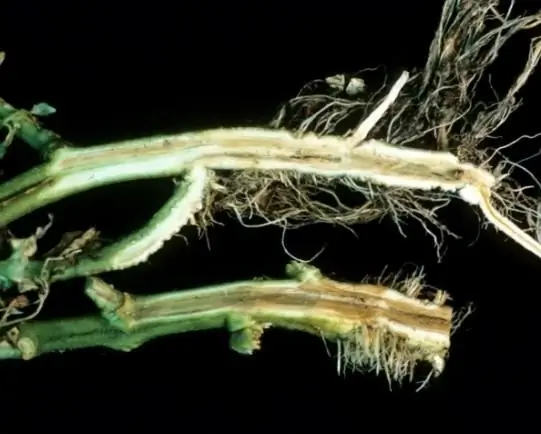2026 Author: Howard Calhoun | [email protected]. Last modified: 2025-01-24 13:10:47
Fusariosis wilt, or Fusarium, is an infectious fungal disease that affects a wide variety of crops. It is caused by pathogens of fungal etiology (imperfect Fusarium fungi), of which there are about 70 species in nature. They can manifest themselves as parasites or semi-parasites, saprophytes or symbionts, however, long-term studies have shown that the disease mainly affects plants weakened due to other factors.

Pathogens most often penetrate the plant through the root system and subsequently cause its death. An extensive branched mycelium develops inside the vascular system, as a result of which the affected plant dies. Fusarium wilt develops very quickly, in fact it occurs a few days after infection.
The disease is common in all climatic zones. In our country, it is most often found in the south, southeast or in the Far Eastern regions. On average, in the most unfavorable years, the yield of different crops can decrease by 40%.
Fusarial wilt of a cucumber at an early stage can be diagnosed by a drooping top during hot hours. If the disease proceeds in an acute form, then the plant witherscompletely and instantly. The root system suffers - the main rhizome dies off, but the lateral processes partially remain viable.
In tomatoes, Fusarium wilt begins with a change in the color of the lower leaves. They become chlorotic and drooping. With the development of the disease, the color of the veins changes - they become brown. Gradually, all the leaves begin to die off, necrosis appears.

Fusarial wilt of strawberries begins with the death of tissue along the edge of the leaves and a slight wilting. Then the petioles and leaves turn brown, and the rosette loses its elasticity and falls apart. May cause rot in high humidity. The plant dies completely after about 1.5 months.
In general, it can be noted that Fusarium wilt can appear at any stage of the plant's life cycle, but most often it occurs during the flowering period.
How infection occurs
The main source of infection is contaminated soil. Therefore, plants in greenhouses most often suffer, where the soil does not change and crop rotation is not applied. Another cause of Fusarium is infected seeds. Mushrooms develop and grow with the plant, and then destroy it.

Fusarial wilt: disease prevention and control measures
Protection of planting material will prevent the possibility of introducing pathogens into the seed bed. Good soil digging, loosening, substrate replacement, crop rotation and tool disinfection also lead toreduce the risk of disease. Mushrooms develop well at high air temperature (about 28 ° C), high humidity and short daylight hours. Therefore, greenhouses must be well ventilated. As a preventive measure, it is necessary to inspect the beds once a week and identify the affected plants. Diseased specimens are removed and burned. Good results are shown by preliminary steaming of the soil and its disinfection with special biological preparations based on fungal antagonists. Of the chemicals, Privekur can be used.
Recommended:
Nuclear power plants. Nuclear power plants of Ukraine. Nuclear power plants in Russia

Modern energy needs of mankind are growing at a gigantic pace. Its consumption for lighting cities, for industrial and other needs of the national economy is increasing. Accordingly, more and more soot from burning coal and fuel oil is emitted into the atmosphere, and the greenhouse effect increases. In addition, there has been more and more talk in recent years about the introduction of electric vehicles, which will also contribute to the increase in electricity consumption
The largest power plants in Russia: list, types and features. Geothermal power plants in Russia

Russia's power plants are scattered in most cities. Their total capacity is enough to provide energy for the entire country
Aeration plants: definition, types, principle of operation, production plants and do-it-yourself tips

Installation of the aeration column provides for the connection of a sump so that it has two flushing modes - direct and reverse. Combined use allows you to wash the filter element more efficiently. It is better to take a bigger mud trap. Small filters become clogged within a short time and require frequent rinsing. It is better to use a glass flask
Fusarial wilt of tomatoes is a disease that is easier to prevent than to cure

With Fusarium wilt, the leaves turn yellow, dry out, and a dark ring is clearly visible on the cut of the diseased plant. Sometimes a light gray or white fluffy coating appears at the base of the stem
The most famous diseases of garden strawberries: Fusarium wilt

Strawberry is a tasty but capricious berry that requires special care. If you do not create favorable conditions for its growth, then garden strawberries can be affected by diseases, and part of the crop or even all plants may disappear

